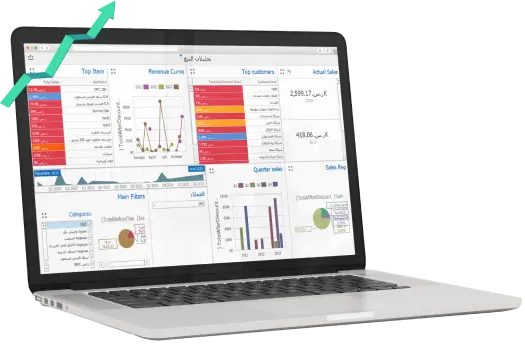It is common for companies to prefer cash sales to guarantee payment and reduce credit costs . However competition and required sales size lead companies to enlarge credit sales . Credit management forms a major part of financial administration because it increases sales and in turn earnings . But the high rate of clients’ credits lead to more investing costs of receivable accounts . the effectiveness of the credit policy is decided by making a comparison between the cost ( investment with receivable credits ) and the revenue ( sales increase ) . Meaning that it is the decision to enlarge or reduce the clients’ credits which really matters because it affects the sales and profitability of the company and also its available liquidity . So it must be studied carefully .
There is a set of accounting standards that are used to evaluate the client’s ability to get a trade credit .
The reputation of the client in the market or that if he deals with the companies in cash and his withdrawal is well .
The capability of the client to pay and his cash flow .
The client’s capital and how he depends on self funding or loans .
Guarantees presented by the client such as checks with a double value of the credit or a promissory note in some companies .
The market state and economy of the country .
The clients’ credit limits :
In the clients’ deferred accounting system there must be a credit limit for each client ( that is the utmost credit he could get ) and also the period of the credit . He has to pay during this period otherwise the software won’t allow him to pay another bill until he gets the approval of the administration .
Therefore the clients’ accountant must have a report of the invoices of clients’ debts which is very important . This report lists the debt in the form of an invoice dividing the credit aging into periods from one to 30 days and from 30 to 60 days , a lso from 60 to 90 and so on
Hence every client should have his credit duration and the limit can’t be exceeded without the approval of the general manager .
Credit duration is the period between the date of the invoice and its maturity date , for example 30 days .
If the invoice is dated 30 / 6 and it was not paid till then there will not be another one even if the credit limit allows so unless the administration approves it .
It is possible to make more than one invoice for the client provided that he pays each one before the end of the credit duration ( for example 30 days or 60 )
Suppose that the client is El Salaam and the duration is 60 days and the credit limit is one million
Today he received a bill of 50 thousands and the limit became 500 thousand . After 60 days he couldn’t pay the bill so he can’t get another one until he pays the previous bill although his credit allows this .
Every client has his own credit duration for his bill and a limit that can’t be exceeded without the approval of the general manager which is mainly based on the evaluation of the administration to each individual client . In addition there are many other risks that face the company when it gives credit and monitors the debit accounts such as the size of those accounts and the study and analysis of debits ages and dividing them according to their maturity ( every 10, 20 , 30 days etc…..) Then the rate of each set to the gross debts and using this rate as a cycling rate and the average collection period then comparing this rate to the credit period listed in the credit policy of the company and figure out the causes of deviation and treat them .
It is the clients’ accountant who follows up the debit of each client with every received invoice and its maturity date . Using this report facilitates the accrual of clients’ invoices and determining the collection amounts expected in the coming financial periods .
The cost of account receivable investments ( forward clients )
Investment of clients is controlled by two factors : the cost of investment and the sales revenue resulting from enlarging credits . The financial administration has to study and balance the size of investment in accounts receivable . This is related to the financial liabilities of the company .their maturity dates ,policy of sales and collection and credit duration which will be given to the clients . Of course each class of clients has its own period according to the size of treatments .There must be a connection between the credit duration and the time of payment for suppliers in order to avoid any insolvency . The company should make a constant evaluation for its clients and compare the sales size to the credit duration given to the clients . If the company increases or decreases the credit limit or the credit duration , how will this affect the sales , debit balances , collections from the clients and on the written off debts and collection cost ( if existed ). and the need for liquidity .
There are some points that must be considered in credits and investment of accounts receivable
The size of supply and demand in the market and the good or bad economic conditions.
If there is a good collection management that follows up the debits constantly .
The company's production capability and its share in the market .
The type of goods and their demand flexibility .
Clients’ debit accounts form frozen sums with costs represented in the cost of investment of involved amounts .Meaning that the company invests its money in forward sales and at the same time there is no collection of the sales on time because the sale is forward not in cash which is called the cost of investment in accounts receivable .
This is besides the opportunity cost that is the amount invested by the company in forward sales and their collection is delayed if they would have been collected on time and invested in any other activity the company would have another revenue which is called the opportunity cost .
Moreover the cost of delay in collection and the present value of money especially in the case of inflation , the rising of foreign currency prices and the decline of local currency value on delaying debts collecting . Also there is the cost of written off debts when there is a forward sale and the possibility of not collecting the debits . Furthermore there is the cost of collecting that is the cost of following up the clients .
When the company decides to enlarge or decrease the credits of the clients this is serious because it affects the sales size and the company profitability the the available liquidity in the company and if the company increased or decreased the credit limit or the credit duration and the effect on sales and accounts receivable , on collecting from clients and on the written off debits and the collection cost (if existed ).
To compare between the credit policy and suggested policy we choose that which leads to a higher net revenue then we compare the cost and revenue of increasing or decreasing the credit .
Cash discount
This means when the client pays his bill during a certain period before the end of his credit duration , he can have a discount predetermined by the company and this is applied in some companies which deal with retailers and wholesalers .
The reason for using the cash discount is to speed up the cash movement in the company so that it can pay for its liabilities and decrease written off debts .
Cach discount is related to pricing decisions as the company can increase prices if it offers a cash discount or increases the credit duration but the company has to convince the client to take advantage of the cash discount .
Hence cash discount involves the trade- off between two alternatives.
Getting a cash discount :
Getting use of credit duration
Getting a cash discount will be good for the company as the sales will increase and cash will be available but the profits margin will decrease . If you get use of credit duration without the discount , the movement of cash flow will be affected because of the delay in sales collecting but the profits margin will be higher compared to the clients’ payment during the discount period. Comparing costs and revenues determine whether the company uses cash discount as one of its credit policies or not .










